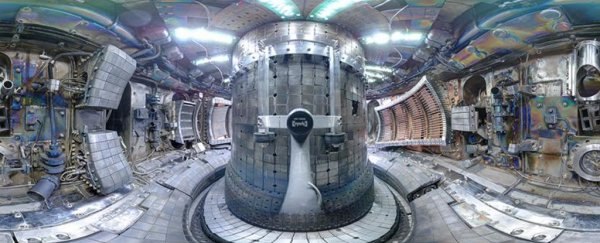Extracting useful amounts of energy from the merging of atoms is tricky business, not least thanks to the challenges of controlling squirming clouds of ultra-hot plasma.
Our clean power fusion goals could be a step closer now researchers have tweaked their fusion recipe to add a new ion to the mix. This allows researchers to get a better grip on how high-energy charged particles move not just inside reactors on Earth, but potentially provide insights into how they behave in stars.
A team of researchers at MIT have used data from experiments conducted on a type of fusion reactor called a tokamak to explore how adding a third ion to the more traditional two-ion plasma mix shakes things up.
The approach allowed the researchers to develop a way to analyse the efficiency of speeding up charged particles using waves of electromagnetic radiation, which is hugely important in our quest to get more energy from fusion reactions than we currently put in.
In principle, fusion is the recombining of sub-atomic particles from simple, plentiful elements into larger elements, releasing useful amounts of energy in the process.
The benefits would be huge. Unlike nuclear fission, there is theoretically zero waste (and practically very little), and there is no need to refine radioactive ores for fuel.
The worst thing that could possibly be said about the process is it releases large numbers of high velocity neutrons. Thankfully these can be absorbed by a blanket of lithium, where they can be recycled to make more fuel.
Fusion could also beat most forms of renewable in its flexibility; there'd be no need to rely on the right location or weather conditions for a ready power supply.
Unfortunately getting atomic particles into a state where they can break apart and build back together requires some pretty delicate physics.
The Sun has the luxury of space and huge amounts of gravity to confine its matter. We need technology that can add enough energy to bring the right kinds of particles close together.
A device such as MIT's currently mothballed Alcator C-Mod tokamak does this by using magnetic fields, which allow the plasma to get ridiculously hot – like 150 million degrees Celsius kind of ridiculous – without vapourising its container.
This hot, moving plasma produces its own contrasting electromagnetic fields, which is as fun as it sounds. Basically this makes the whole affair much like trapping worm-filled jelly with rubber bands.
For all of this trouble, you'd want a decent amount of bang for your buck.
In spite of decades of hard work, we're just barely at a point where we can keep plasma running at a high enough performance for efficient periods.
Any advances that can help keep this jelly under control for longer periods, while putting less energy in and getting more power out, is a huge bonus.
That's where this research comes in. One way to get the plasma moving around inside a tokamak is to use a process called ion cyclotron resonance heating (ICRH).
Antennas outside of the tokamak send the right frequency of radio waves through the plasma to excite its particles, a bit like the world's most complicated microwave oven.
To make it more efficient, the plasma is generally made up of two kinds of ions, such as 5 percent hydrogen ions (or protons) and 95 percent deuterium ions (a proton plus neutron).
This difference means the hydrogen ions heat up to much higher energies, allowing them to slam into deuterium and spit out particles that in turn collide with the tokamak's outer shell, producing heat which can be turned into power.
So what if trace amounts of a third type of ion are added?
The researchers used the data from past experiments on the Alcator C-Mod tokamak that added a tiny one percent helium-3 to the mixture and studied the complex effects this had on the wriggling plasma's behaviour.
Researchers at the UK's Joint European Torus, the largest fusion device in Europe, were so impressed by the results they replicated them and contributed their own measurements.
The experiments found the addition resulted in a ten-fold boost in energy. Helium ions were being pushed into the realm of megaelectronvolts, a whole magnitude higher than anything achieved before.
"These higher energy ranges are in the same range as activated fusion products," says researcher John C. Wright from MIT's Plasma Science and Fusion Center.
"To be able to create such energetic ions in a non-activated device – not doing a huge amount of fusion – is beneficial, because we can study how ions with energies comparable to fusion reaction products behave, how well they would be confined."
To clarify, this isn't yet an operating fusion reactor, but a testing of predictions that's given us a technique for modelling more complex mixtures that have potential to yield more power more efficiently.
While our eyes are on more efficient reactors on Earth, astrophysicists would be interested in how such models could help explain fusion inside the Sun.
Fully functional fusion is still on the horizon, at least a good decade or more in the future by some of the more optimistic accounts. But it's starting to look like it really could become a reality, and one that can't come soon enough.
This research was published in Nature Physics.
